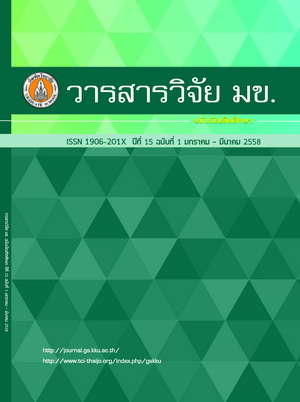การหาปริมาณโลหะเหล็ก ทองแดง ตะกั่ว และสังกะสีในน้ำเม่า โดยเทคนิคเฟลมอะตอมมิกแอบซอร์พชันสเปกโทรเมทรี (Determination of Iron, Copper, Lead and Zinc in Mao Juice by Flame Atomic Absorption Spectrometry)
Keywords:
Mao juice (น้ำเม่า), Flame atomic absorption spectrometry (เฟลมอะตอมมิกแอบซอร์พชันสเปคโทรเมทรี), Heavy Metal (โลหะหนัก)Abstract
จากการศึกษาหาปริมาณเหล็ก (Fe) ทองแดง (Cu) ตะกั่ว (Pb) และสังกะสี (Zn) ในน้ำเม่า 5 ตัวอย่าง ที่สุ่มจากจังหวัดสกลนครและชัยภูมิจำนวน 5 ตัวอย่าง ด้วยเทคนิคเฟลมอะตอมมิกแอบซอร์พชันสเปกโทรเมทรี นำตัวอย่างน้ำเม่ามาย่อยด้วยกรดไนตริก (65%w/v) อัตราส่วน 2:1 โดยปริมาตร และเติมไฮโดรเจนเปอร์ออกไซด์ ในขั้นตอนการวิเคราะห์ พบว่าช่วงกราฟมาตรฐานเป็นเส้นตรงของโลหะมีความเข้มข้นในช่วงที่แตกต่างกันดังนี้ 2.0-6.0, 1.0-5.0, 1.0-20.0 และ 0.2-1.0 มิลลิกรัมต่อลิตร สำหรับให้เติม Fe, Cu, Pb และ Zn ตามลำดับและมีค่าสัมประสิทธิ์สหสัมพันธ์ (r2) > 0.997 และค่า LOD และ LOQ ของเหล็ก และทองแดง มีค่าเท่ากันคือ 0.012 และ 0.04 มิลลิกรัมต่อลิตร ตามลำดับ สำหรับตะกั่ว เท่ากับ 0.195 และ 0.65 มิลลิกรัมต่อลิตร และสังกะสี เท่ากับ 0.063 และ 0.21 มิลลิกรัมต่อลิตร ตามลำดับ มีค่าการคืนกลับ อยู่ในช่วง 83.1-92.9% (Fe), 85.1-99.1% (Cu), และ 90.5-105% (Zn) ความเข้มข้นของโลหะที่พบในตัวอย่างน้ำเม่า มีค่า 8.65-10.26 (Fe), 1.46-3.08 (Cu) , และ 3.90-4.42 (Zn) มิลลิกรัมต่อลิตร ในขณะที่ Pb ไม่สามารถตรวจวัดได้ จากการเปรียบเทียบการหาปริมาณโลหะในตัวอย่างน้ำเม่าโดยวิธีกราฟมาตรฐานกับวิธีเติมสารละลายมาตรฐาน พบว่าปริมาณของโลหะมีค่าไม่แตกต่างกันอย่างมีนัยสำคัญ ดังนั้นตัวอย่างน้ำเม่าที่เป็นสินค้า OTOP จากจังหวัดสกลนคร และชัยภูมินี้ มีความปลอดภัยต่อผู้บริโภคภายใต้มาตรฐานผลิตภัณฑ์อุตสาหกรรมไทยที่กำหนดปริมาณสูงสุดของโลหะที่ยอมรับได้สำหรับ Fe 15 มิลลิกรัมต่อลิตร Cu และ Zn 5 มิลลิกรัมต่อลิตร และ Pb 0.2 มิลลิกรัมต่อลิตร
ABSTRACT
The determination of iron (Fe), copper (Cu), lead (Pb) and zinc (Zn) in five commercial Brands of mao juice, from SakonNakhon and Chaiyaphume provinces, using flame atomic absorption spectrometry were studied. Each juice sample were heated on hot plate in fume cupboard and consequently digested with concentrated nitric acid (65%w/v) with the ratio of 1:2 (v/v) in association with small amount of hydrogen peroxide. The analytical method was also validated. It was found that the calibration curves for vanous metals was constructed with different concentration (mg/L) ranges of 2.0-6.0, 1.0-5.0, 1.0-20.0, and 0.2-1.0 with linear correlation coefficients (r2) > 0.997 for Fe, Cu, Pb and Zn, respectively. Both LOD and LOQ values were 0.012 and 0.04 mg/L for both Fe and Cu of 0.195 and 0.65 mg/L for Pb; 0.063 and 0.21 mg/L for Zn, respectively. The percentages of recovery were 83.1-92.9% (Fe), 85.1-99.1% (Cu), and 90.5-105% (Zn). The metals concentrations (mg/L) in these mao juices were found to be 8.65-10.26 for Fe, 1.46-3.08 for Cu, 3.90-4.42 for Zn, while Pb could not detected in all samples. In addition, the quantitative analysis was also calibrate by comparing the results between an external calibration curve and standard addition method. The results showed no significantly different data for all of these metals. It is clear that the commercially available OTOP mao juices bottled products from Sakonnakhon and Chaiyaphume provinces can be safety consumed under legislation of Thai Community Products Standards with the maximum permissible levels of 15 mg/L (Fe), 5 mg/L (Cu and Zn) and 0.2 mg/L.


